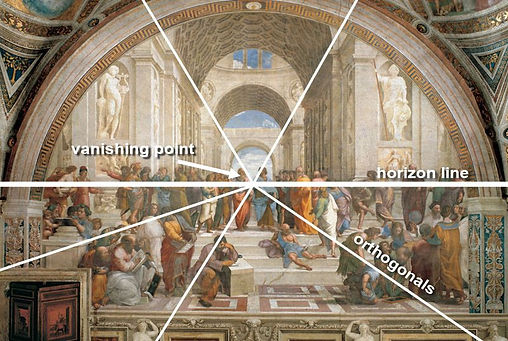ILLUSTRATION 279D
Masaccio (Peter and the Tribute Money): *
This work is considered a milestone in Art History world. It is the first to use scientific linear one point perspective in which all the orthogonals point to 1 vanishing point (in this case, Christ). If you were to walk into the painting, you could walk around Jesus Christ, in the semicircle created, and back out the painting again with ease.
Piero della Francesca (Federigo & Battista of Urbino portrait): *
Atmospheric perspective is used to soften the contours of the landscape as they recede into the distance. The soft colours & radiant atmosphere are evocative of Rogier van der Weyden & Jan van Eyck, both well known in Italy. As well the artist appropriates a Flemish technique to create a feeling of luminosity thru the use of oil glazes. Humanist (Classical) influences are reflected in the double portrait, the triumphal processions (evoking ancient Roman triumphs) & the sharp, numismatic profiles (again indicative of the antique style).
Perugino (Christ Giving the Keys): *
The main figures are organized in a frieze in 2 tightly compressed rows close to the surface of the picture, & below the horizon. Christ hands the silver and gold keys to St. Peter, who is surrounded by the other Apostles. The flat, open square is divided by coloured stones into large foreshortened rectangles. In the centre background is a temple resembling Alberti's ideal church. Scattered in the middle distance are 2 scenes from the life of Christ, including the Tribute Money on the left and the stoning of Christ on the right. The style of the figures is inspired by Verrocchio. The octagonal temple of Jerusalem dominates the central axis & serves as a backdrop in front of which the action unfolds. Perugino has made a significant contribution in rendering the landscape. The sense of an infinite world that stretches across the horizon is stronger than in almost any other work of his contemporaries. The feathery trees against the cloud-filled sky with the bluish-gray hills in the distance represent a solution that later painters would find instructive, especially Raphael.
Raphael (the Vatican stanze): * see EndNote<G>
The Stanza della segnatura ("Room of the Signatura") was the first to be decorated by Raphael's frescoes. Its theme is worldly and spiritual wisdom & the harmony which Renaissance humanists perceived between Christian teaching and Greek philosophy. The most famous of all these frescos is the School of Athens. It represents natural Truth, acquired through reason. Under the arched vault of an immense Basilica with lacunar ceiling and pilasters, (echoes Constantine's in the Roman Forum), decorated with statues of Apollo and Minerva, a crowd of philosophers and wise men of the past, with High Renaissance artists and patrons, argue among themselves or mediate. The extraordinarily deep linear perspective creates an incredible illusion of depth.



